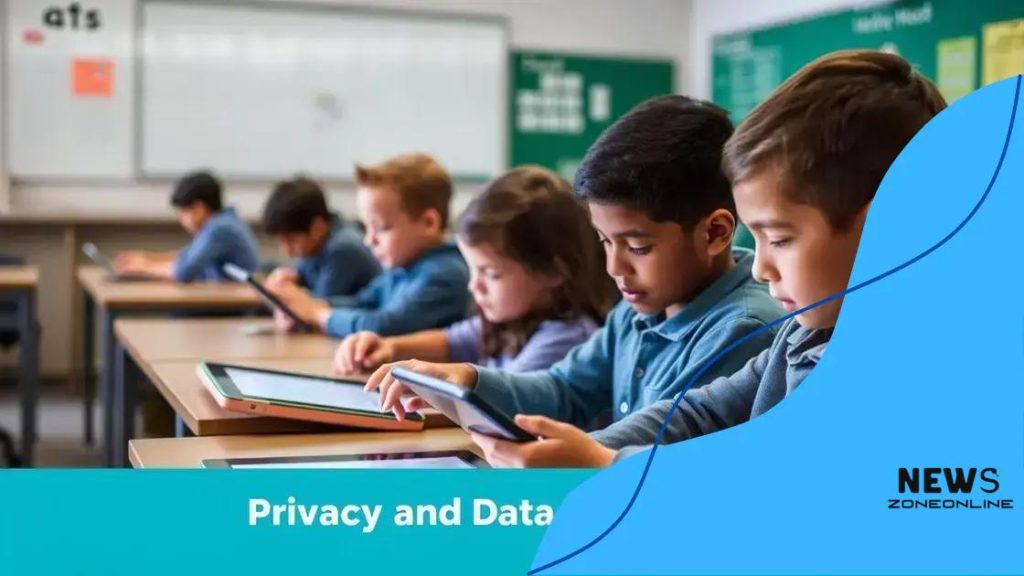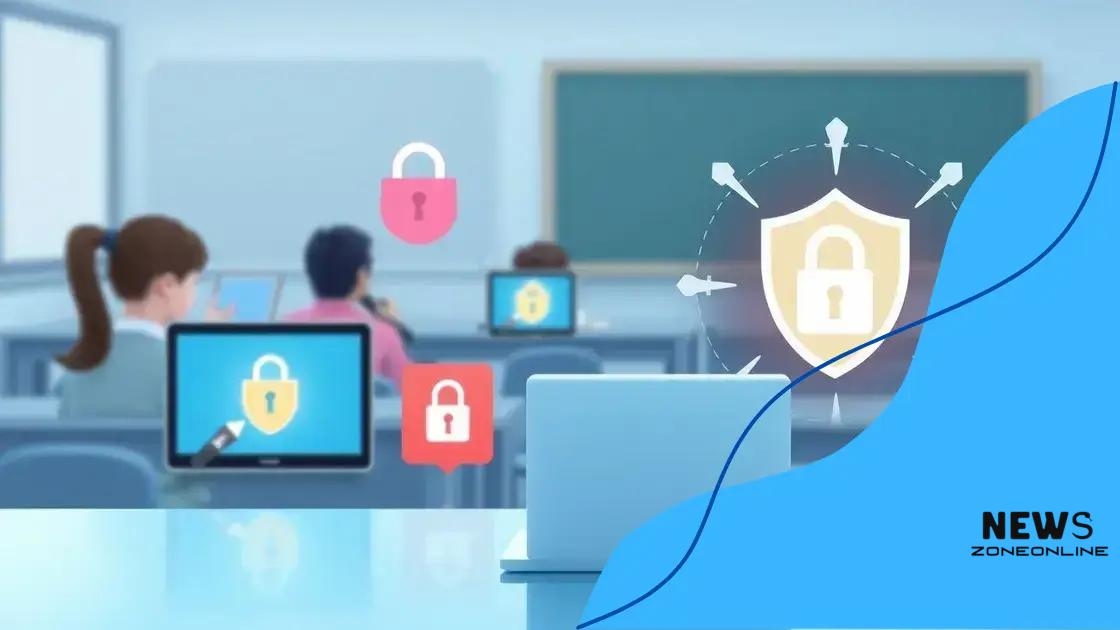Student data protection in EdTech tools

Student data protection in EdTech tools requires schools to implement strong security measures, educate staff and students, and comply with regulations to safeguard sensitive information against evolving cyber threats.
Student data protection in EdTech tools is an essential topic that many educators and parents should care about. Think about how often students use technology today—it’s everywhere! But what happens to their data? In this article, we’ll dive into the importance of protecting student information in the digital age.
Understanding student data privacy regulations
Understanding student data privacy regulations is vital for educational technology developers and schools. These regulations help ensure that students’ personal information remains secure while they engage with digital tools.
Key Laws and Regulations
Several laws dictate how student data should be handled. These regulations are designed to protect students and their information. The most significant ones include:
- FERPA: The Family Educational Rights and Privacy Act gives parents certain rights regarding their child’s education records.
- COPPA: The Children’s Online Privacy Protection Act places restrictions on the online collection of personal information from children under 13.
- GDPR: The General Data Protection Regulation is a comprehensive data protection law in the EU that affects how student data can be processed.
Schools must comply with these regulations to avoid legal issues and ensure that student data is handled appropriately. Non-compliance can lead to severe penalties and loss of public trust.
Importance of Compliance
It’s crucial for educational institutions to understand these laws. They serve to create an environment where students can learn without fear of their data being misused. When schools adhere to these privacy regulations, they build a relationship of trust with students and parents. Being compliant also ensures that educational technology companies can operate smoothly without facing legal hurdles.
Moreover, training staff on data privacy and implementing strong protocols can help safeguard sensitive information. By doing so, schools not only comply with laws but also create a safe learning environment.
Best practices for data security in EdTech
Implementing best practices for data security in EdTech is critical for protecting students’ information. As schools increasingly rely on technology, they must ensure secure handling of sensitive data.
Robust Password Policies
One of the simplest yet most effective measures is to enforce strong password policies. Educators and students should use complex passwords that include a mix of letters, numbers, and symbols. Regularly updating passwords enhances security.
- Use at least 12 characters.
- Change passwords every three months.
- Avoid common passwords and personal information.
Additionally, implementing two-factor authentication can significantly reduce the risk of unauthorized access.
Data Encryption
Data encryption is another essential practice. By encoding sensitive information, even if data is compromised, it remains unreadable. Schools should ensure that both stored data and data in transit are encrypted.
Encryption protects personal information, making it harder for cybercriminals to exploit stolen data. It’s important for educational institutions to consult with IT professionals to apply effective encryption measures.
Regular Security Audits
Conducting regular security audits is vital for identifying vulnerabilities. These audits assess the current security measures in place and highlight areas that need improvement. Together with audits, staff training plays a crucial role in raising awareness about security risks.
After audits, institutions should address issues immediately to close gaps in security. This proactive approach can prevent potential breaches and cultivate a safer digital environment.
How technology impacts student data protection

Technology plays a significant role in shaping student data protection. As classrooms become more digital, understanding this impact is crucial for educators and administrators.
Enhancements in Data Security
Modern technology offers various tools that enhance data protection. Advanced encryption algorithms, secure cloud storage, and robust authentication methods help keep student information safe from unauthorized access.
- Encryption: This ensures that even if data is intercepted, it cannot be read without the proper keys.
- Cloud Storage: Many EdTech tools use secure cloud services that provide backup and recovery options.
- Authentication: Multi-factor authentication adds a layer of security when accessing sensitive data.
These technologies create a safer environment for student information, allowing schools to focus more on education.
Emerging Risks
While technology improves data security, it also introduces new challenges. Cyber threats are evolving, and schools must stay vigilant against potential attacks.
Schools must educate staff and students about these risks. Data breaches can lead to identity theft and loss of trust. Regular training sessions help keep everyone informed about the latest security practices. It’s important for everyone involved to recognize phishing attempts and understand the significance of secure coding practices.
Investing in cybersecurity tools and resources is vital for any educational institution aiming to protect sensitive student information.
Reinforcing Policies with Technology
Finally, technology can help reinforce internal data protection policies. Learning management systems can track access and monitor data usage. This transparency helps keep everyone accountable. By using technology to enforce policies, schools can establish clear guidelines for handling and sharing student data effectively.
Key challenges in safeguarding student information
Safeguarding student information comes with several challenges that educational institutions must address. The digital landscape is constantly changing, and with increased technology use, the risks associated with data protection also grow.
Data Breaches
One of the major challenges is the rising number of data breaches. Cybercriminals target schools more frequently because they often hold valuable personal information.
- Ransomware attacks: These can lock schools out of their own systems until a ransom is paid.
- Phishing scams: Attackers may trick staff into giving away sensitive information.
- Weak security practices: Some institutions fail to implement up-to-date security measures, making them more vulnerable.
As a result, it’s crucial for schools to invest in robust cybersecurity strategies that protect against these threats.
Staff Training
Another challenge is the lack of training among staff and students about data privacy. Many teachers and students may not understand proper data handling practices. Regular training sessions on security protocols can make a big difference.
When everyone is aware of potential risks and best practices, the chances of human error decrease significantly. Staff should be knowledgeable about recognizing suspicious emails and securely managing data. Keeping information secure isn’t just a task for IT; it’s a shared responsibility across the entire institution.
Compliance with Regulations
Schools also face difficulties complying with various data protection regulations. Laws like FERPA and COPPA can be complex and may change over time.
Staying up-to-date with these regulations requires ongoing effort. Institutions need policies that align with current laws and ongoing audits to ensure compliance. Failure to comply can lead to fines and damage to reputation, further complicating the challenge of safeguarding student information.
Future trends in student data protection
Future trends in student data protection are evolving quickly as technology continues to advance. Schools must stay informed about these trends to adapt and improve their data security practices.
Increased Use of Artificial Intelligence
One significant trend is the increased use of artificial intelligence (AI) in data security. AI can identify potential threats more quickly than humans and learn from past incidents. This capability allows schools to proactively manage data risks.
- Threat detection: AI algorithms can analyze patterns in data usage and flag unusual activities.
- Automation: AI can automate security measures, ensuring timely responses to incidents.
- Data analysis: It can help in understanding and predicting potential vulnerabilities based on data trends.
As AI technology continues to develop, educational institutions can leverage it to strengthen their security protocols.
Enhanced Privacy Regulations
Another trend involves stricter privacy regulations. Governments are focusing more on protecting student data, leading to the introduction of new laws that demand compliance from schools.
These regulations will likely require institutions to implement more robust privacy measures and enhance transparency about how data is collected and used. Keeping up with these regulations will be crucial for schools to avoid penalties and maintain trust.
Data Minimization Practices
Data minimization is becoming a critical practice. Schools are encouraged to collect only the data that is essential for their operations. This approach reduces the amount of sensitive information at risk in a breach.
By assessing and limiting the data gathered, educational institutions can protect students better and simplify their compliance efforts with privacy regulations.
As we look forward, collaboration between educators, technology providers, and policymakers will be crucial to creating a secure environment for student data. Together, they can drive innovations that prioritize security and privacy.
FAQ – Frequently Asked Questions about Student Data Protection
What are the primary risks to student data security?
The primary risks include data breaches, phishing attacks, and inadequate security measures. Schools must remain vigilant to protect sensitive information.
How can schools educate students and staff on data protection?
Regular training sessions, workshops, and easy-to-understand materials can help raise awareness about data protection best practices for both students and staff.
What regulations should schools be aware of concerning student data?
Schools need to comply with regulations such as FERPA and COPPA, which govern the privacy and protection of student information.
How can technology improve data protection in education?
Technology can enhance data security through AI-driven threat detection, encryption, and secure cloud storage, making it difficult for unauthorized users to access sensitive data.





